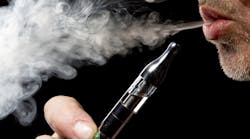No Puffs About It: E-cigarettes Might Not be the Answer in Smoking Cessation Programs
While some companies work to improve worker health with smoke-free workplaces and cessation initiatives, a new study finds that using e-cigarettes as a method to quit might not be as healthy as previously thought.
The breakdown of propylene glycol and glycerin, the two solvents most commonly found in most e-liquids, leads to emissions of toxic chemicals such as acrolein and formaldehyde, according to the study which was published in Environmental Science & Technology.
"Advocates of e-cigarettes say emissions are much lower than from conventional cigarettes, so you're better off using e-cigarettes," said Hugo Destaillats, Berkeley Lab researcher and the study's corresponding author in a statement. "I would say that may be true for certain users--for example, long time smokers that cannot quit--but the problem is, it doesn't mean that they're healthy. Regular cigarettes are super unhealthy. E-cigarettes are just unhealthy."
In addition, the amount of toxic emissions varies from the first time a user puffs the liquid to further on in the “puff cycle,” or consecutive puffs in one sitting. Emissions levels vary depending on the device, the battery voltage, and the emitted compound, according to the study.
To test effects due to device aging, researchers used a single device over nine consecutive 50-puff cycles without cleaning. The research found an increase of emissions of formaldehyde, acetaldehyde, and acrolein.
"We found there are emissions of toxic chemicals at any temperature at which you use the device," Destaillats said. "And the higher the temperature, the more emissions."
Researchers also vaporized liquids consisting solely of the solvents to verify that they were the source of the emissions. In all, the researchers detected significant levels of 31 harmful chemical compounds, including two that had never been previously found in e-cigarette vapor--propylene oxide and glycidol, both of which are probable carcinogens, according to the research.
